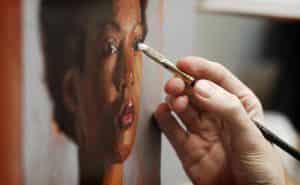How to paint a black & white portrait in Oils
This is a time-lapse video of a classical approach to a black & white grisaille portrait painting.
It accompanies a free series of 5 step by step, portrait tutorials.
Click here to read How to paint a portrait in Oil : Part 1





This is absoultely wonderful. I began thinking about doing a black and white portrait painting in my head, then thought that I rarely see them; so I researched and this is by far the most beautiful one yet. Love it and I am totally inspired to create one of my own.
Great to hear it Megan! looking forward to hearing how your black and white portrait turns out.
Cheers,
Will
Absolutely lovely.
Thanks Angela
This portrait is beautiful and so expertly executed. You make it look so easy yet that is often the way of a true master. I might have to give it a shot though as it is very inspiring. Just love you website and all the ideas it conjures up.
Hi Susan, thanks very much, very kind of you to say so. Great to hear you’ve been inspired to have a go at your self portrait!
Let me know how you get on.
Cheers,
Will
Hi, I’m trying to follow your examples and techniques but wanted to continue in colour. Do you ever follow on from the black and white portrait by building colour glazes on top to produce a finished colour portrait?
Hi Gerard,
You can build up a black and white portrait with coloured glazes but I don’t have a tutorial on it at the moment.
I am planning a colour portrait course, but initially it will be more focused on colour mixing recipe, rather than glazing techniques over the top of a black and white portrait.
As most beginners find getting basic skin tone mixes difficult, it will focus on opaque skin tone mixes.
Cheers,
Will
Hi Will, I’m really inspired by your website. I have no training whatsoever and would like to attempt a sepia colored portrait. Would one just start with the raw umber underpainting and just increase the values with wvery subsequent layer?
Hi Regan, have a look through this oil portrait demo.
Hope it helps,
Cheers,
Will
Hi Will,
No doubt the paintings are amazing specially the Portraits..!but I still find it really difficult in India to find just the right colour types for my paintings. if only you could suggest the right type of paints that i could look for..that may suit both portrait and scenic paintings..
Hi Priya, you might find this article helpful.
Cheers,
Will
Hello Will,
I found your website in 2014. The black and white oil portrait tutorial had me running out to buy new brushes. I worked through the steps and was very excited with my final result, until I showed it around. Unanimous response was ‘that’s not you, is it?’
A year later, I’m wondering if I can somehow redo the old painting. Is there any value in trying to correct a portrait gone off?
All the best!
Hi Nicole, pleased you enjoyed the tutorial, yes you could redo the old painting by applying a thin ‘oiling out’ layer to the canvas and then working ontop of that. Personally, I would start a fresh painting so you have a record of your progress as a painter and a record of yourself.
Cheers,
Will
hi will,
i am a fan of your art work and teaching method.
thanks for all the knowledge that you share…
i am using a single coated acrylic cotton canvas for oil painting.
but the surface is not absorbing hence the paint glides on the surface.
issue is that i can not paint over the portion i painted few minutes back.
neither do i know if i am correctly dressing the brush with medium (alkyd)
many times the brush stroke i end with is not covering the surface
could you please help ?
Hi Liya, it might just be the absorbency of that particular canvas, if you have another canvas of the same brand try applying a coat of gesso to the canvas first and then start the painting.
Cheers,
Will
hi will kemp
thanks for your prompt reply
when i watch art videos on portrait oil painting the artist go over the painted area more than once to correct the value or hue of the color.i am wondering how it happens as the wet surface having the oil paint on lets the next coat of paint come in without mixing up or sliding. when the artist applies the next coat of paint, it simply gets absorbed.
would you please clarify this point ?
Thanks a ton for all your hep
Regards
Liya
Hi Liya, it’s all dependent on the amount of paint on the brush, the thickness of the paint underneath, the softness of bristle of the brush and the amount of pressure used to apply the paint.
If you imagine a jam sandwich (stay with me here!) and you apply butter to the bread, and then apply jam ontop.
If you apply a small amount of jam and spread hard with the knife it will mix in with the butter, whereas if you have lots of jam on the knife and apply lightly over the butter you won’t disturb the layer underneath – it’s exactly the same principle with painting.
Hope this helps,
Cheers,
Will
I have the home-studio I’ve wanted since I was a kid. I filled it with canvas, oils, watercolors, essentially, everything I would use, a vast array of art materials I know I’ll use. Now that I’m getting older and am able to commit to the canvas, I found that my painting techniques disappeared and I’ve gained perspective while pushing the child-like artwork aside (good and not-so). I began searching for classes to refine my own style, as an adult. Since moving to this new area years ago, I’m not familiar with the local universities so I was somewhat open to do virtual classes though I do much better when I can ask questions, however, finding your website was like a mega lightbulb going off in-front of me! In my home and next to easels that I’m working, your text and videos are helping me so much! You’ve already taught me how to adjust my overhead lights (& spot lights) and THAT has made a HUGE impact while painting, THEN, you broadly explained why I continue to run into the same issues over and over again, it’s not so much a painting issue as it’s a DRAWING issue! Your words CLICKED as though I was inside a classroom ! At the moment, I’m typing you while a major hurricane (Hurricane Matthew) is literally impacting my area in South Florida and when all businesses are closed and all people are safely tucked away, I knew I would get to watch your portrait video (and others), FULLY. I’ve always wanted to paint portraits that resemble the subjects however each time I’ve constructed a portrait, the areas were great when viewed individually, however, the areas didn’t fit together properly (for instance, the head, arms, torso, all look fine until I put them together) and now I’m learning, from you, why that is and have already leaped over many years of great abstract/impressionistic paintings though now I see the paintings with the addition of realistic perspective. Thank you ! I look forward to enrolling in drawing & oil/canvas through your website!
Hi David, so pleased you’ve been finding the lessons helpful and seeing the benefits of concentrating on the drawing into your paintings and portraits. Great that the studio lighting article helped and hope you’re keeping safe with Hurricane Matthew!
Will
Hi Will
This tutorial is so helpful. I love your self portrait. Very soon I hope to purchase your oil glazing course. I just wanted to ask your opinion on the necessity of an underdrawing in a painting. I’ve been studying with a lovely teacher who has taught me a lot about tone—but who doesn’t believe in doing any drawing when painting. Instead it’s all done tonally, beginning with the wipe-out technique, using a rag. Personally, I’m finding this rather problematic because, I find, fundamental errors get introduced along the way but are not noticed till quite late in the painting process. It then becomes laborious and frustrating to have to fix them so far into the painting. My teacher believes drawing is important but is adamant that it should be kept entirely seperate from the painting process. (This is why Is want to do your course, as it seems one has a lot more control along the way) Would love to hear your thoughts. Cheers, Jenny
Hi Jenny, really pleased you found it helpful, it’s a personal preference really, some artists like to work up very detailed drawings underneath whilst others like to ‘draw with the paint’ I often find it’s easier to see the issues first in a tonal or monochromatic way as it’s much easier to tweak than when you’re working in a full palette from the start.
Cheers,
Will
Thanks Will.
Hi Will, Just found your site and tried my first oil painting and first (self) portrait, working alongside your excellent written instruction. I made so many mistakes that even Bob Ross wouldn’t call ‘happy accidents’ however I’m excited to learn more. My question is – where do I begin?
I don’t have any formal training but I’ve been sketching and digitally painting for fun for years and have some watercolor experience. Is there a classical order to follow – sketching, to still life, to portraits? I’ve love to claim that I am patient and want to start from the ground up, but in all honestly I’m impatient (the cause of the some of the errors in my initial attempt I’m sure!) and itching to get to oil painting portraits. In short, not looking for the online equivalence of a Florence school education! Whats the minimum I can get away with? Cheeky I know :)
Thanks so much for sharing your talent and tips.
Best, Sarah-Jane
Hi Sarah-Jane, yes ateliers tend to work from drawing, to charcoal, to painting in black and white with still life, to painting still life with a limited palette, building up to portraits with a full palette.
Cheers,
Will